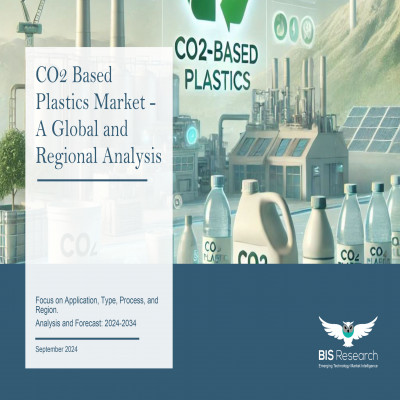Introduction to Asia-Pacific CO2-Based Plastics Market
The Asia-Pacific CO2-based plastics market is projected to reach $4,308.9 million by 2034 from $74.9 million in 2024, growing at a CAGR of 49.97% during the forecast period 2024-2034. The increasing emphasis on reducing carbon emissions and securing sustainable materials is drastically changing market dynamics in the Asia-Pacific (APAC) region. Specifically, changing environmental rules and the quick development of carbon capture and utilisation (CCU) technology are transforming the plastics business. APAC governments are enforcing stricter environmental regulations and pressuring businesses to switch to more efficient and clean production techniques. Cross-sector partnerships that promote innovation and tackle urgent environmental issues also help these initiatives.
CO?-based plastics are becoming more popular as a competitive substitute as APAC businesses react to mounting regulatory pressure and consumer demand for greener products. Low-carbon production is becoming more practical thanks to technological advancements, which also help businesses increase operational effectiveness and lessen their environmental impact. This change is especially noticeable in markets like China, Japan, and South Korea, where national sustainability agendas and public-private partnerships are giving green innovation top priority.
The APAC market is positioned as a rapidly developing leader in sustainable production thanks to the combination of industry collaboration, technical innovation, and legislative backing. In line with worldwide trends towards a circular economy and a low-carbon future, this trend reaffirms the region's dedication to striking a balance between economic expansion and environmental responsibility.
Market Introduction
The market for CO?-based plastics in Asia-Pacific (APAC) is expanding as the area moves towards more ecologically friendly and sustainable production methods. As worries about plastic pollution, carbon emissions, and climate change increase, industries around Asia-Pacific are looking at creative substitutes for conventional plastics made from petroleum. A promising alternative is provided by CO?-based polymers, which employ collected carbon dioxide as a feedstock to lower greenhouse gas emissions and promote the objectives of the circular economy.
Governments in important nations including China, Japan, South Korea, and India are enforcing more stringent environmental laws and providing incentives for the creation and uptake of low-carbon technologies. The development of CO?-based polymers is being aided by these regulatory initiatives as well as rising investments in carbon capture and utilisation (CCU) technologies. Additionally, growing demand from industries including consumer products, automotive, and packaging is increasing market potential.
Public-private partnerships, research projects, and industry collaborations are boosting innovation and assisting in the expansion of production throughout the region. Significant growth is anticipated because to continued innovations and supporting legislative frameworks, even though obstacles like high manufacturing costs and inadequate infrastructure still persist. CO?-based plastics are positioned to be a key component of the region's sustainable material transition as APAC continues to industrialise while striving to meet climate commitments.
Market Segmentation:
Segmentation 1: by Application
• Packaging
o Films
o Bottles
o Containers
o Trays
• Automotive Components
o Interior Components
o Structural Parts
• Construction Materials
o Pipes
o Panels
o Insulation
• Electronics Components
o Casings
o Connectors
o Circuit Boards
• Textile Processing
o Fibers
o Non-Woven Fabrics
• Others
Segmentation 2: by Type
• Polycarbonates
• Polyurethanes
• Polypropylene Carbonate (PPC)
• Polyethylene Carbonate (PEC)
• Polyethylene Terephthalate (PET)
• Others
Segmentation 3: by Production Process
• Electrochemistry
• Microbial Synthesis
• Thermocatalysis
Segmentation 4: by Region
• Asia-Pacific: China, Japan, India, South Korea, and Rest-of-Asia-Pacific
Market trends, drivers and challenges of APAC CO2-Based Plastics Market
Increased demand for sustainable materials, industrial decarbonisation initiatives, and growing environmental concerns are driving the growth of the Asia-Pacific (APAC) CO?-based plastics market. Industries are looking at alternatives to conventional plastics derived from fossil fuels as a result of governments around the region, especially in China, Japan, South Korea, and India, enforcing stricter emission laws and promoting clean technology programs. Technological developments in carbon capture and utilisation (CCU) are making it possible to transform CO? into beneficial polymers, which is in line with APAC's objectives for sustainability and the circular economy. In order to satisfy consumer-driven sustainability goals and regulatory requirements, industries like packaging, consumer goods, and automotive are starting to include CO?-based plastics.
However, the market confronts significant obstacles. Wider use is restricted by high manufacturing costs brought on by the infancy of CCU infrastructure and the requirement for specialised processing equipment. Production capacity is limited by the poor logistics and availability of captured CO? in many APAC nations. Further obstacles include competition from inexpensive conventional plastics and a lack of knowledge about CO?-based substitutes. However, the APAC market is anticipated to develop gradually and play a significant role in the worldwide transition to low-carbon, climate-resilient materials as a result of rising investments in green technology, expanding research activities, and developing public-private partnerships.

